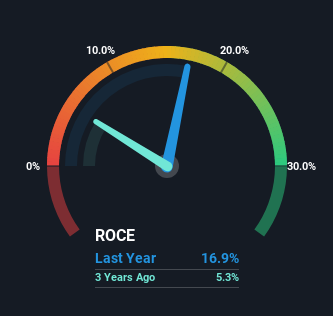- United States
- /
- Hospitality
- /
- NYSE:SIX
Six Flags Entertainment (NYSE:SIX) May Have Issues Allocating Its Capital

To avoid investing in a business that's in decline, there's a few financial metrics that can provide early indications of aging. Businesses in decline often have two underlying trends, firstly, a declining return on capital employed (ROCE) and a declining base of capital employed. This indicates the company is producing less profit from its investments and its total assets are decreasing. In light of that, from a first glance at Six Flags Entertainment (NYSE:SIX), we've spotted some signs that it could be struggling, so let's investigate.
Return On Capital Employed (ROCE): What Is It?
For those who don't know, ROCE is a measure of a company's yearly pre-tax profit (its return), relative to the capital employed in the business. To calculate this metric for Six Flags Entertainment, this is the formula:
Return on Capital Employed = Earnings Before Interest and Tax (EBIT) ÷ (Total Assets - Current Liabilities)
0.17 = US$355m ÷ (US$2.7b - US$615m) (Based on the trailing twelve months to July 2023).
Therefore, Six Flags Entertainment has an ROCE of 17%. On its own, that's a standard return, however it's much better than the 9.6% generated by the Hospitality industry.
View our latest analysis for Six Flags Entertainment

In the above chart we have measured Six Flags Entertainment's prior ROCE against its prior performance, but the future is arguably more important. If you'd like, you can check out the forecasts from the analysts covering Six Flags Entertainment here for free.
What Can We Tell From Six Flags Entertainment's ROCE Trend?
In terms of Six Flags Entertainment's historical ROCE movements, the trend doesn't inspire confidence. To be more specific, the ROCE was 23% five years ago, but since then it has dropped noticeably. On top of that, it's worth noting that the amount of capital employed within the business has remained relatively steady. This combination can be indicative of a mature business that still has areas to deploy capital, but the returns received aren't as high due potentially to new competition or smaller margins. So because these trends aren't typically conducive to creating a multi-bagger, we wouldn't hold our breath on Six Flags Entertainment becoming one if things continue as they have.
Our Take On Six Flags Entertainment's ROCE
In the end, the trend of lower returns on the same amount of capital isn't typically an indication that we're looking at a growth stock. It should come as no surprise then that the stock has fallen 64% over the last five years, so it looks like investors are recognizing these changes. That being the case, unless the underlying trends revert to a more positive trajectory, we'd consider looking elsewhere.
One final note, you should learn about the 5 warning signs we've spotted with Six Flags Entertainment (including 2 which are a bit concerning) .
If you want to search for solid companies with great earnings, check out this free list of companies with good balance sheets and impressive returns on equity.
New: Manage All Your Stock Portfolios in One Place
We've created the ultimate portfolio companion for stock investors, and it's free.
• Connect an unlimited number of Portfolios and see your total in one currency
• Be alerted to new Warning Signs or Risks via email or mobile
• Track the Fair Value of your stocks
Have feedback on this article? Concerned about the content? Get in touch with us directly. Alternatively, email editorial-team (at) simplywallst.com.
This article by Simply Wall St is general in nature. We provide commentary based on historical data and analyst forecasts only using an unbiased methodology and our articles are not intended to be financial advice. It does not constitute a recommendation to buy or sell any stock, and does not take account of your objectives, or your financial situation. We aim to bring you long-term focused analysis driven by fundamental data. Note that our analysis may not factor in the latest price-sensitive company announcements or qualitative material. Simply Wall St has no position in any stocks mentioned.
About NYSE:SIX
Six Flags Entertainment
Owns and operates regional theme and waterparks under the Six Flags name.
Moderate growth potential and slightly overvalued.
Similar Companies
Market Insights
Community Narratives




